Replicating Lopi by Substitution
words and photos by Alexina Hicks
I like Istex lopi yarn. It’s got character, it’s pretty unique in its genre, and it garners the shelves of a huge section in Icelandic grocery stores for more affordable prices than junk food. It isn’t a surprise that many passionate handspinners have conducted extensive studies to determine how to recreate this type of yarn. What if I want to spin a DIY lopi yarn but I don’t have any Icelandic wool? Can I replicate the effect of lopi yarn by substitution? What do I need to get as close as possible to it? For my research to be as exact as possible, I needed to create a database of comparisons between handspun Icelandic lopi and multiple imitation samples. Through differentiation, I can grasp which components make lopi unique and which characteristics to strive for in order to imitate it.
Real deal lopi
For starters, I must define what lopi is. Thus I observed a strand of mill-spun Istex Léttlopi for a quick analysis. It is a singles yarn of about 9 WPI. The Z twist angle is somewhere between 10 and 15 degrees. To the touch, it feels as if it were finished by fulling. This makes sense since the process gives the singles yarn more strength. The composition is a blend of the undercoat and outercoat of Icelandic sheep. The preparation for spinning clearly seems carded as the alignment of the fibers and the halo effect stray away from worsted characteristics.
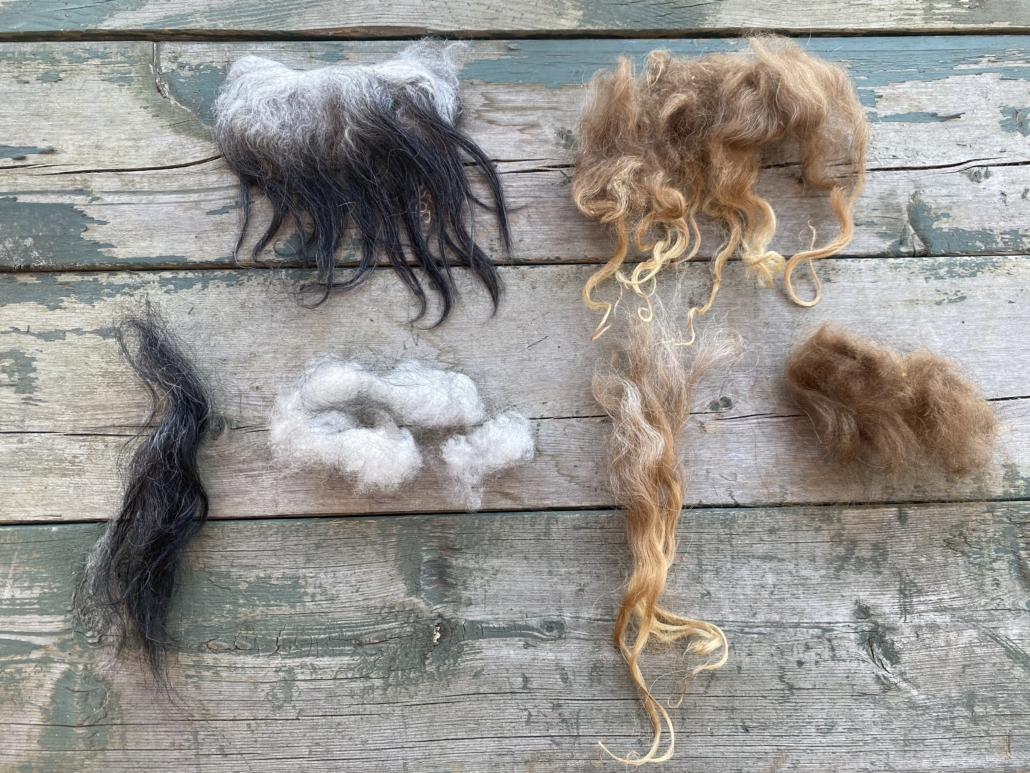
I then moved on to observing the locks from two fleeces I acquired during festival excursions: one golden brown and one stunningly grey and black. My goal was to distinguish the parts that make up lopi. I separated the two coats by hand, pinching the tip of the outercoat and wriggling it playfully right and left as I tugged it out of the undercoat. This undercoat, known as thel, is incredibly soft, airy, and fine. It also feels a little dry. It’s matte in appearance. The crimp is weak, uneven and somewhat flat. It’s a perfect example that low micron is not always synonymous with high crimp. The length is about 2.5 inches long. The outercoat, tog, is very inconsistent in length, ranging from 6 to 9 inches long. Luster is high, and the micron is also clearly high as it quite resembles hair. The crimp is almost non-existent at 3 waves per 5 inches.
I took multiple measures of the tog and thel ratio from the two fleeces. The results were constant, and the average is 45% tog and 55% thel.
From the Icelandic fiber I intended to spin two sample types. In one, the locks were carded as is, like Léttlopi. In the other, I separated the two coats first and then blended them with the measured ratio. I wished to determine if that extra step distorted the lopi. If so, I should expect my replicated samples to be different from the get-go.
I carded and dizzed the wool off into roving. I then settled at the wheel. My Majacraft Rose likes to dance this song to a ratio of 6:1 for a good groove. I drafted at every treadle to keep twist to a minimum. I started with the true lopi preparation. The two lengths and textures interplaying gave me a slight shock. I found that a backwards draft helped pull out both types of fibers. Used to spinning fine, I needed to adjust to fatten my strand to the right size, but the fibers were struggling against me and refusing to offer a constant flow. Once I did get the size I was looking for, suddenly thickness alone seemed to naturally draft out both types of fibers. As I spun the combined preparation, I noticed it was actually a little easier to spin, but wherever the fibers were not perfectly blended, each coat agglomerated when pulled out by the twist.
Once done, I gave the skeins a nice spa treatment with fulling. Then I showed them who’s boss and thwacked them silly. Finally I hung them up and kissed them goodnight. When I returned, they were all relaxed. The first thing I noticed occurred during a rub test on my neck. The yarns have different scratch levels. Between carding the locks and carding the two separated coats together, the first is definitely softer. After mulling it over, I realized that when I positioned the locks onto my hand cards, the thel was the first one to naturally nestle into the tines, while the tog remained in my hand and needed to be layered over. This was contrary to the order in which I had placed my 2 separated coats on the cards to blend them.
I prepped a new sample, separating the 2 coats and layering first tog, then thel. I blended more thoroughly. Once spun up, I’m astonished; the singles yarn is now softer, more similar to the original lopi sample. I knit swatches and can see the tog–then-thel combination stands out: more toothy with wiry stitches and a soft halo missing. The brown wool has a more golden shade from the outercoat. In contrast, the thel–then–tog is almost identical to original lopi.
Replicating with other wools
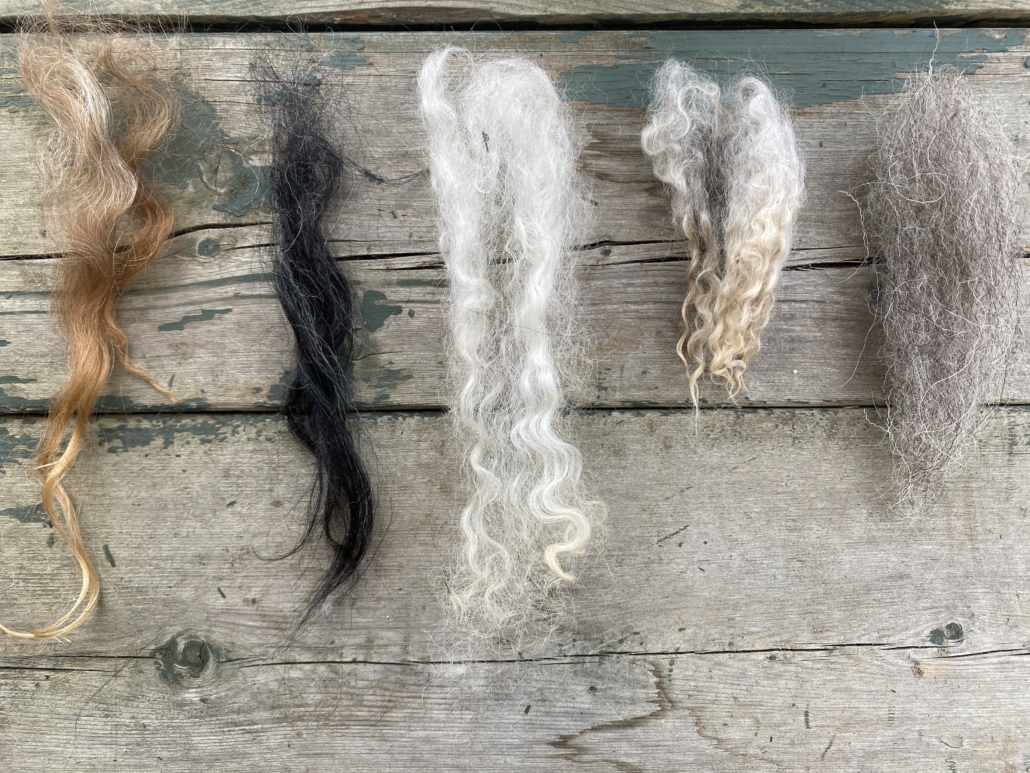
Next was time to be creative and have fun. I did some stashdiving and pulled out participants.
As stand-in for tog, I selected Cotswold and Karakul. Cotswold is similar in luster but shorter, and the crimp is tighter. Karakul is similar in crimp and density but with a much higher micron count, and it is a double-coat blend in itself.
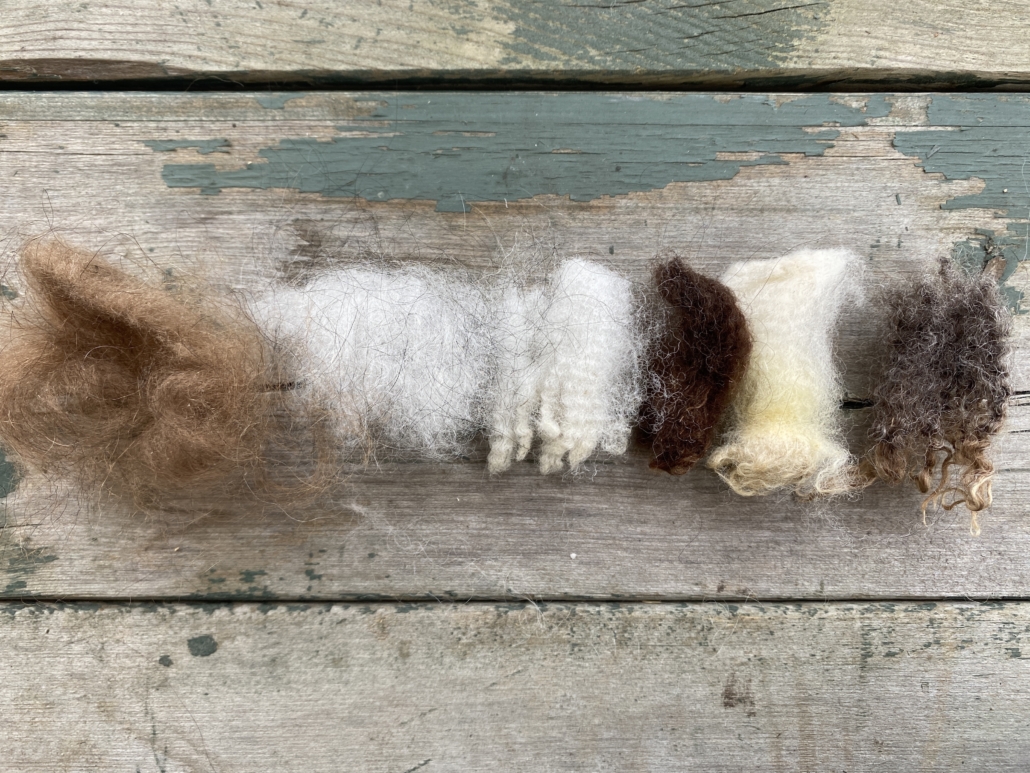
As stand-in for thel, I selected Cheviot, Jacob, and Finn. All three were chosen for their staple length akin to the Icelandic undercoat. Cheviot was chosen for its dryness, Jacob for its similar feel to thel. Finn was chosen for its softness similar to the undercoat and as an attempt to counteract the toothier longwools.
As I got ready to mix wools per ratio, I wavered, wondering if it wasn’t a little sacrilegious to take soft wools and mix them with a coarser fiber. Isn’t the trend to enhance softness? What could motivate this procedure?
The pragmatic answer that comes to mind is science; this experiment extrapolates on the two roles of the Icelandic double-coat: thel offers impermeability and tog helps to cut the wind. If I want to make outergarments, I need to understand how to imitate lopi to maximise these traits. I also find a reason coming from the heart. I enjoy spinning all wools, including that of coarser breeds. But I don’t always have a project to match the spin because the result is too rough for my skin. A lopi imitation would give extra meaning to those longwools we love to spin but aren’t sure we want to wear.
I started with two mixes: Karakul/Jacob and Karakul/Finn. During spinning they both feel more puffy and are easier to draft out. The resulting yarns are similarly dry to the Icelandic ones, but are lacking sheen. In retrospect, I realize the Karakul’s undercoat must have affected the ratios of my sampling with more shorter fibres, which are matte and voluminous. Knit up, Karakul/Finn has a round stitch similar to Icelandic. Karakul/Jacob yields a flat fabric and is the most rustic of all the yarns. Still, I’m pleasantly surprised to discover that although the Karakul mixes are rougher than Icelandic, they feel softer as a fabric than as a yarn, and I’m comfortable at the idea of wearing them.
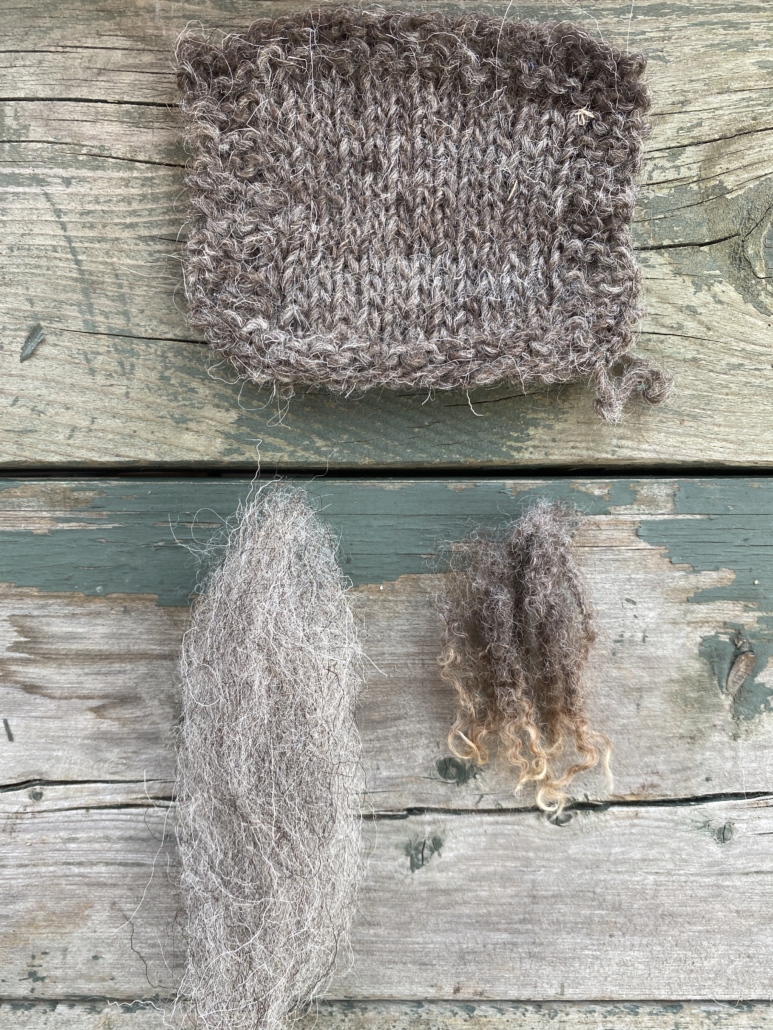
Karakul/Finn 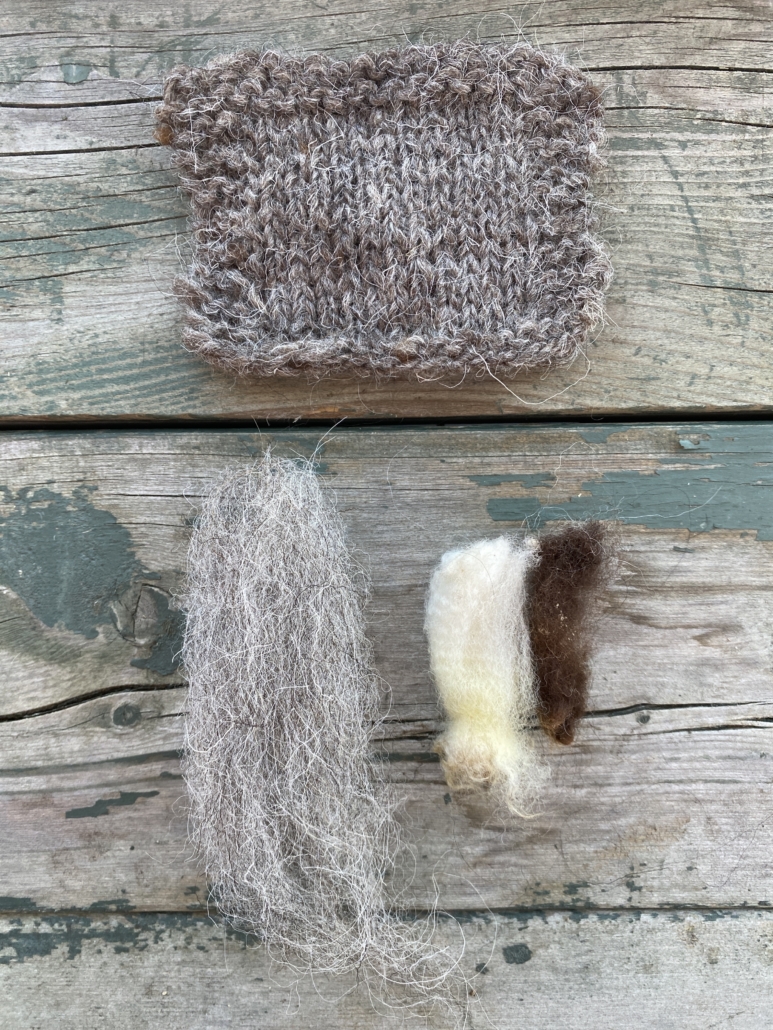
Karakul/Jacob 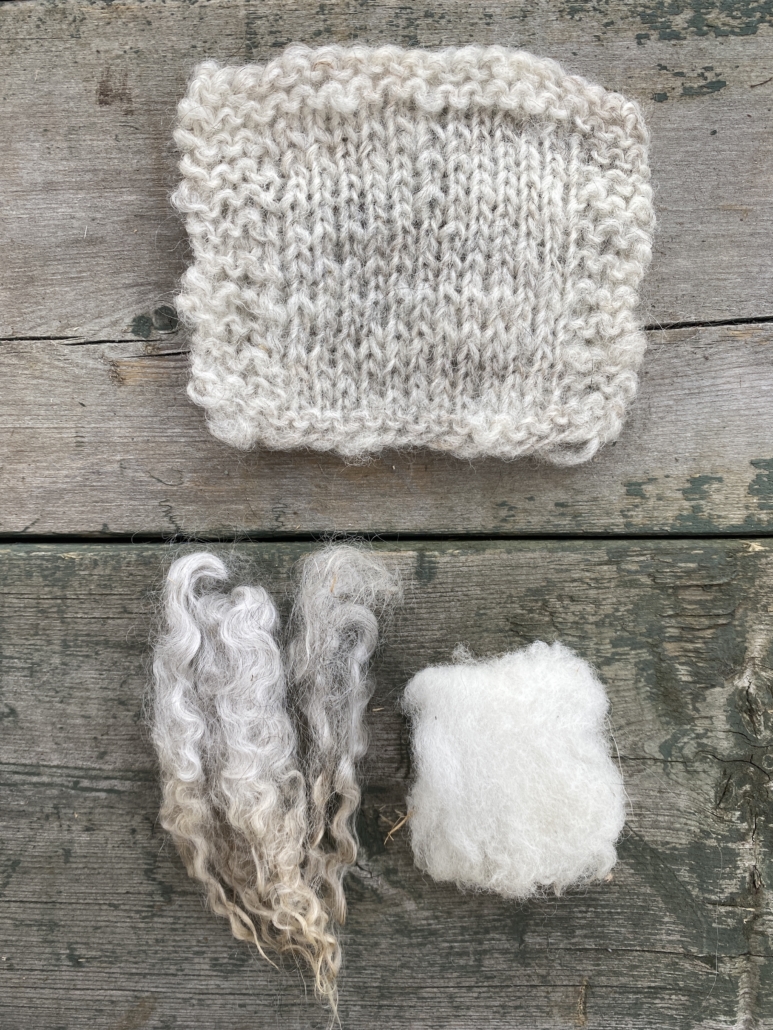
Cotswold/Cheviot
I also spun Cotswold and Cheviot, which achieves a halo, but the longwool clearly has more fibres per weight than tog. Knit up, the yarn is more stringy and dense. Furthermore, the general appearance and texture is clearly down-like.

I moved on to Cotswold and Finn. This mix certainly feels amazing, but it’s definitely not as dry. It’s slightly softer but not by much. The glow from the Cotswold shines through, imitating Icelandic.
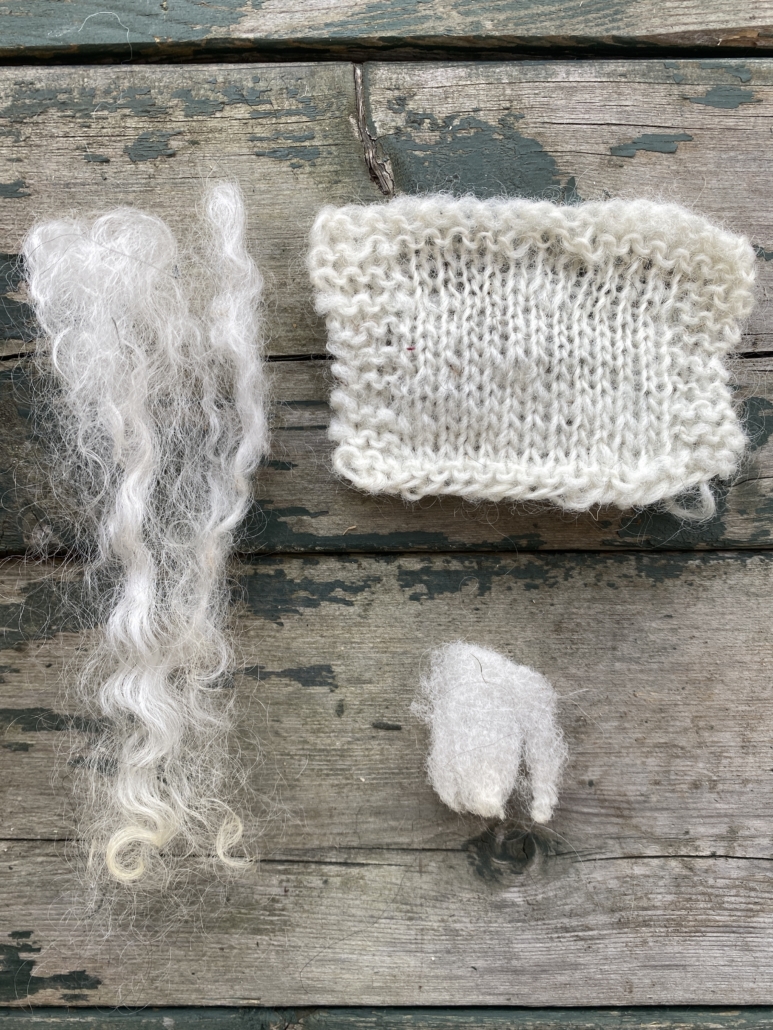
Finally I tried combining some super long Cotswold (about 11 inches long) with my short Cheviot that barely reached 2 inches. I could only spin the longer fibers and the shorter ones surrounded the core unevenly, giving a wacky halo without actually gripping properly into the twist. The knit swatch shows a thin stitch and the Cheviot gives a chalky but diaphanous complexion and texture.
A difference shared by all mixes compared to Icelandic is elasticity. The Icelandic skeins have maintained the same circumference from when they came off the niddy-noddy. The others have shortened, pulled tight by the crimp of the short wools. We can also clearly see it in the width of the knit swatches.
Verdict: Can I make a true fake lopi?
All things considered, Icelandic wool is incomparable. But so is each type of wool. However, my answer is a little more nuanced regarding the necessity to make lopi exclusively with Icelandic wool. Let’s look at it this way: Can I make waffles without using wheat flour? If I use something else, are they no longer waffles? With the right adjustments, I can get close to the real thing. The taste is a little different, but the shape and presentation make the cut. So why not make a substitute yarn and call it a lopi?
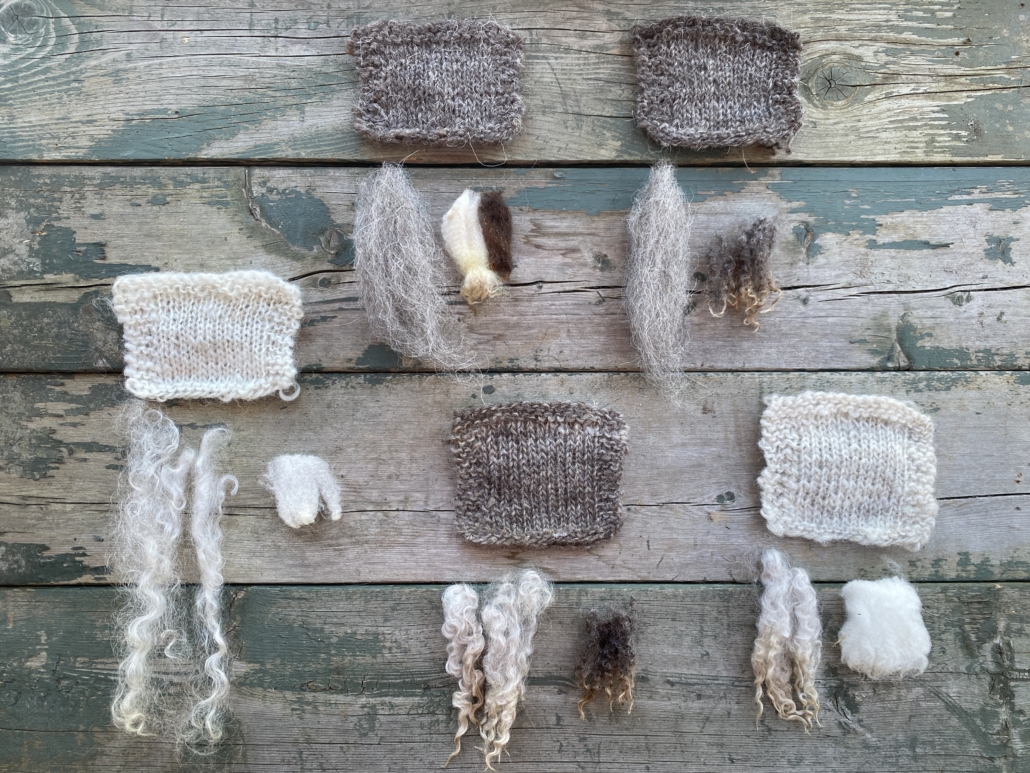
If you wish to make a DIY lopi with your fiber stash, here are key elements that contribute to proper substitution:
- Weigh for a ratio. Aim for a bit more of the shorter, finer stuff (around 55%) and a bit less than half of the coarser, longer stuff.
- Layer the shorter fibers first when carding.
- Blend your short and long fibers well.
- Plan for a moderate difference in length between your two types of fibers, estimated at a third.
- Check your crimp since it will drastically impact the thickness of your singles and the elasticity. For example, the Cheviot felt like an outsider with its helical crimp dominating the yarn.
- Aim for luster in at least one of your ingredients.
- Adjust softness levels by compensating one wool’s micron with the other.
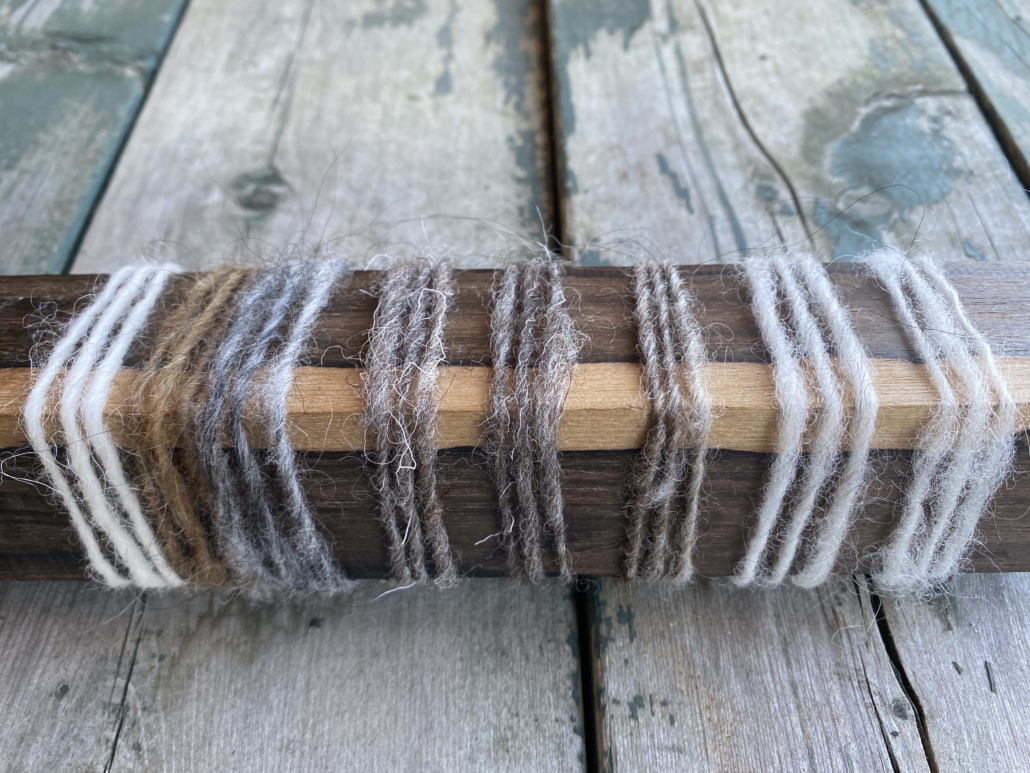
Afterthoughts
Every step of the process was rewarding. The act of knitting the yarns triggered an irresistible desire to initiate woolly projects. I’m inspired to use coarser wools, and I’ve gained the confidence that I can make something wearable with them.
Even though rice flour waffles aren’t the same as whole wheat ones, the flavours brought on by substitution can still be rich and welcome. Luckily this principle applies likewise to my spinner’s diet!
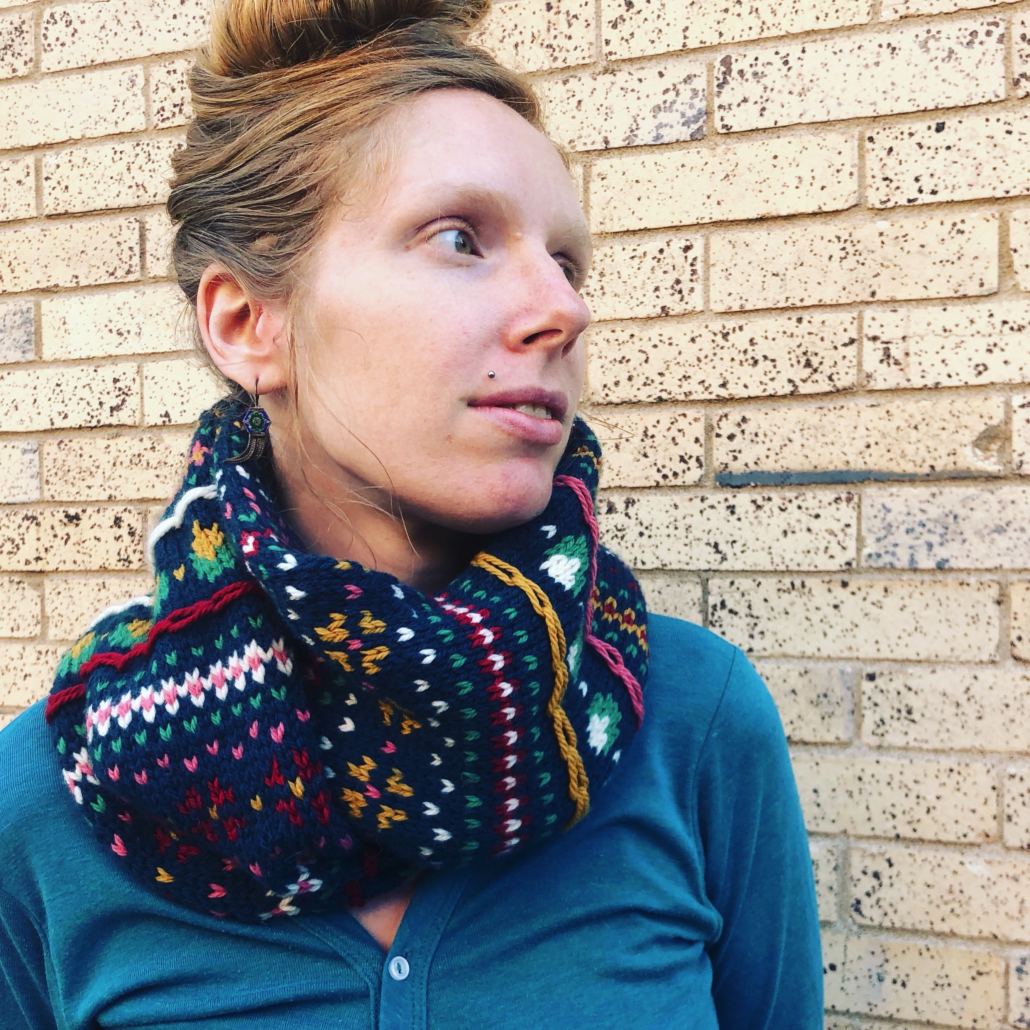
Alexina Hicks with her husband and their children live in the charming countryside of Quebec, Canada, where she dedicates her days to her Master Spinner studies and teaches spinning, knitting, and all things in-between. Together with her darling man they form L’aime Laine (The Wool Lover), creating spindles and other spinning tools as well as handprocessed fibres from local farms. Learn more at www.alexinahicks.com.
Lopi par substitution
écrit par Alexina Hicks
Je suis de celles qui aiment la laine Istex lopi. Elle a du caractère, elle est unique en son genre et elle garnit les étagères d’une grande section des épiceries islandaises pour des prix plus abordables que les croustilles. Ce n’est donc pas surprenant que plusieurs fileuses passionnées aient déjà mené des études élaborées pour déterminer comment imiter ce type de fil. Et si par exemple je souhaitais filer une laine lopi DIY, mais que je n’avais pas de fibres islandaises? Est-ce que je pourrais imiter l’effet d’une laine lopi par substitution? Quelles seraient les conditions nécessaires pour arriver au meilleur résultat?
Ce questionnement offre l’opportunité d’une nouvelle étude. Afin que ma recherche soit la plus pertinente possible, je dois monter une base de données comparative entre la lopi islandaise filée à la main et de multiples échantillons d’imitation. C’est en les examinant que je cernerai quels éléments rendent la lopi unique et quelles caractérstiques viser.
La vraie affaire
Tout d’abord, il me faudrait définir ce qu’est la lopi. J’observe donc le fil provenant d’un écheveau Istex Léttlopi de filature pour une analyse rapide. C’est un brin d’environ 9 TPP (tours par pouce). L’angle de torsion se situe entre 10 et 15 degrés. Au toucher, on sent que le fil a été bloqué par chocs thermiques, sans agitation. C’est logique puisque le procédé offre plus de force au brin seul. Comme la plupart des lecteurs le savent, la composition est un mélange du sous-manteau et du manteau externe des moutons islandais. La préparation de filage semble clairement cardée puisque l’alignement des fibres et l’effet de halo s’éloignent des caractéristiques du style “worsted”.
(Photo 1) J’observe ensuite les mèches de deux sublimes toisons acquises lors de mes excursions dans des festivals, dont une brun doré et l’autre exquise par ses tons contrastants de gris et de noir. Mon but est de distinguer les parties formant la lopi.
Je sépare les deux manteaux à la main en pinçant la pointe des longues fibres pour les extraire du sous-manteau, avec des secousses de gauche à droite, tout en tirant. Ce sous-manteau, connu sous le nom de thel, est très doux, léger et fin. Il semble un peu sec et il est d’apparence mate. L’ondulation est faible, inégale et en quelque sorte aplatie. C’est un bon exemple qui démontre qu’un micron bas n’est pas toujours synonyme d’une ondulation prononcée. La longueur est d’environ 2.5 pouces. Le manteau externe, le tog, est très inconstant en longueur, passant de 6 à 9 pouces de long. Le lustre est fort et le micron aussi, car la fibre s’apparente aux cheveux. L’ondulation est quasi inexistante avec 3 ondulations par 5 pouces.
Je prends plusieurs mesures du ratio tog versus thel sur les deux toisons. Les résultats sont constants et la moyenne est de 45% tog et 55% thel.
À partir de la fibre islandaise j’ai l’intention de filer deux types d’échantillons. Dans le premier, les mèches seront cardées telles quelles, comme la Léttlopi. Dans le second, je séparerai d’abord les deux manteaux puis je les mélangerai selon le ratio calculé. Je souhaite déterminer si cette étape supplémentaire changera le comportement du fil lopi. Si oui, je dois m’attendre à ce que mes échantillons d’imitation soient différents de prime abord.
Je carde et passe dans un diz pour créer un ruban. Je m’installe au rouet. Mon Majacraft Rose chéri me raconte qu’il aime danser sur cette chanson à un ratio de 6:1 pour un bon rythme. J’étire la fibre à chaque coup de pédale pour garder ma torsion au minimum. Je commence avec la préparation originale de lopi. L’interaction des deux longueurs et textures me causent un léger choc. Un étirage arrière m’aide à extirper les deux types de manteaux. Habituée au filage fin, je dois m’adapter pour élargir mon fil à la bonne taille, mais les fibres me résistent et refusent de former un fil égal. Une fois la taille recherchée atteinte, la largeur semble soudainement se calibrer pour marier naturellement les deux types de fibres. Je passe ensuite à la préparation combinée et je remarque qu’elle semble plus facile à filer. Cependant, là où le mélange n’est pas parfaitement égal, les manteaux ont tendance à s’agglomérer séparément.
Une fois le filage terminé, je donne aux deux écheveaux un traitement spa nordique avec chocs thermiques. Ensuite je leur montre qui est le boss avec une bonne fessée. Finalement, je les suspends, les embrasse et leur souhaite une bonne nuit. À mon retour, ils sont sagement détendus.
Lors du fameux test de “frotter dans le cou”, je fais ma première observation. Les laines varient dans leurs degrés de “piquant”. Entre carder les mèches et carder ensemble les deux manteaux, la première préparation est définitivement plus douce. Après réflexion, je réalise que lorsque j’ai appliqué les mèches sur mes cardes à main, le thel se logeait naturellement entre les pics en premier, alors que le tog restait dans ma main et devait être appliqué par-dessus. C’est le contraire de l’ordre dans lequel j’ai placé les manteaux séparés.
(Photo 2) Je prépare un nouvel échantillon en séparant les deux manteaux et en appliquant en premier le tog, ensuite le thel. Je mélange plus méticuleusement. Une fois filé le brin m’épate: il est maintenant plus doux, plus semblable à l’échantillon de lopi original. Je tricote des carrés tests et je vois que la combinaison “tog-puis-thel” sort du lot. Elle est plus rêche avec des mailles maigres et un halo manquant. La couleur en est même affectée, s’approchant de la teinte plus dorée du manteau extérieur. (Photo 3) En contraste, le “thel-puis-tog” est presque identique à la lopi d’origine.
Reproduire avec d’autres fibres
Le but est d’être créative et de m’amuser. Je sélectionne mes participants. (Photo 4) Pour remplacer le tog, je choisis le Cotswold et le Karakul. Le Cotswold est semblable en lustre, mais plus court et avec une ondulation plus étroite. Le Karakul a une ondulation et une densité similaires, mais avec un micron plus élevé et des fibres constituées d’un double manteau. (Photo 5) En tant que remplaçant du thel, je choisis le Cheviot, le Jacob et le Finnois. Tous trois ont été choisis pour leur longueur proche de celle du sous-manteau islandais. De plus, le Cheviot est choisi pour sa sécheresse, le Jacob pour son toucher semblable et le Finnois pour sa douceur analogue au sous-manteau et pour contrer les fibres longues plus rugueuses.
Alors que je me prépare à mélanger les laines par ratio, j’hésite, me demandant si ce n’est pas sacrilège de prendre des laines fines pour les combiner avec des fibres plus rêches. Le réflexe habituel n’est-il pas d’augmenter la douceur? Qu’est-ce qui motiverait cette démarche?
La réponse pragmatique qui me vient à l’esprit est de le faire au nom de la science. Cette étude extrapole sur les deux rôles des manteaux islandais, le thel offrant de l’imperméabilité et le tog aidant à couper le vent. Si je souhaite créer des vêtements d’extérieur, je dois comprendre comment imiter la lopi pour maximiser ces caractéristiques. Mais je découvre aussi une raison venant du coeur. J’apprécie de filer toutes les laines, incluant celles des variétés plus rustiques. Mais je n’ai pas toujours un projet qui s’agence au filage, car le résultat est trop rude pour ma peau. Une imitation de lopi donnerait d’autant plus de valeur aux fibres longues que nous aimons filer, mais que nous ne sommes pas certain de vouloir porter.
Je commence avec deux mélanges; Karakul/Jacob et Karakul/Finn. Durant le filage, ils sont plus faciles à étirer. Les fils qui en découlent sont semblablement secs comme l’islandais, mais tous deux manquent d’éclat et sont plus gonflés. Avec le recul, je réalise que le sous-manteau du Karakul doit avoir affecté les ratios de mon échantillonage avec les fibres plus courtes qui sont mates et volumineuses. (Photo 6) Au tricot, le Karakul/Finn a une rondeur de mailles semblable à de l’islandais. (Photo 7) Le tissu Karakul/Jacob a un rendement aplati et est le plus rugueux de toutes les laines créées. Tout de même, je suis agréablement surprise de découvrir que malgré la rusticité plus grande des mélanges Karakul, ils sont plus doux au toucher une fois tricotés qu’en tant que simple fil. Je suis à l’aise avec l’idée de les porter. (Photo 8)
Je file aussi du Cotswold avec du Cheviot. J’atteins un effet d’halo, mais le Cotswold a clairement plus de fibres par poids que le tog. Tricoté, l’effet est plus dense et filiforme. De plus, l’apparence générale et la texture sont clairement spécifiques aux laines de “type down”. (Photo 9)
Je passe au Cotswold avec Finnois. Ce mélange est très plaisant, mais n’est définitivement pas aussi sec. C’est légèrement plus doux. L’éclat du Cotswold ressort et imite celui de la lopi.
(Photo 10) Finalement, je tente de combiner du Cotswold très long, d’environ 11 pouces, avec mon Cheviot qui peine à atteindre 2 pouces. Il en résulte que je me retrouve à ne pouvoir filer que les fibres longues, les plus courtes s’enroulant autour sans intégrer la torsion, créant un halo. L’échantillon tricoté montre des mailles minces et le Cheviot impose une apparence crayeuse et diaphane.
(Photo 11) En comparaison à l’islandais, une différence partagée par tous les mélanges est l’élasticité. Les écheveaux de fibres islandaises ont maintenu la même circonférence que lorsqu’ils ont été enlevés du mandrin. Les autres écheveaux ont plutôt rétréci, ramenés par l’ondulation des fibres courtes. Cela est mis en évidence par la largeur des échantillons tricotés. (Photo 12)
Verdict: Puis-je faire une vraie fausse lopi?
Tout bien considéré, la fibre du mouton islandais est incomparable. Ce qui est aussi vrai pour toutes les fibres. Ma réponse est toutefois nuancée sur la nécessité d’utiliser la laine islandaise pour faire la lopi. En effet ne puis-je pas faire des gauffres sans utiliser de la farine de blé? Si j’utilise une autre farine, peut-on dire que ce ne sont plus des gauffres? Avec les ajustements adéquats je peux en préserver l’essence. Le goût peut être différent, mais la forme et la présentation sera celle d’une gauffre. Alors pourquoi ne pas faire une laine substitut et lui reconnaître le procédé d’une lopi?
Si vous souhaitez faire une lopi DIY avec vos réserves de fibres, voici les éléments clés qui contribueront au succès de vos substitutions. (Photo 13)
- Peser vos fibres selon le ratio. Visez une plus grande quantité de fibres courtes et fines (environ 55%) et un peu moins que la moitié des fibres plus longues et rustiques.
- Déposer les fibres courtes en premier sur la carde.
- Mélanger bien vos fibres (les courtes et les longues).
- Prévoir un écart de longueur modéré entre vos types de fibres, estimé à un tiers.
- Vérifier les ondulations, car cela aura un impact significatif sur l’épaisseur de votre brin ainsi que sur son élasticité. Par exemple, le Cheviot détonnait avec son ondulation hélicoïdale qui dominait le fil.
- Sélectionner au moins un ingrédient pour son lustre.
- Ajuster les niveaux de douceur en compensant le micron d’une laine avec une autre. (Photo 14)
Pensées après coup
Toutes les étapes du processus étaient gratifiantes. En tricotant, au simple contact des laines filées, un désir irrésistible de concrétiser des projets laineux s’installe. Je me sens maintenant inspirée à l’idée d’utiliser des laines plus coriaces. Jai également gagné en confiance qu’elles puissent devenir un vêtement non seulement confortable, mais pratique à porter.
Même si la farine de riz n’a pas les mêmes caractéristiques que la farine de blé, les saveurs amenées par la substitution sont tout de même riches et bienvenues. Heureusement ce principe s’applique aussi à ma diète de fileuse!
Alexina Hicks habite la belle campagne québécoise avec son mari et leurs enfants où elle se dédie à ses études de Maître Fileuse et enseigne le filage, le tricot et tout ce qui entoure ces disciplines. Avec son amoureux ils forment L’aime Laine, créant des fuseaux et autres outils du filage, ainsi que des fibres préparées à la main provenant de fermes locales. Apprenez-en plus sur www.alexinahicks.com.
PLY Magazine believes that Black lives matter, as well as LBGTQI+ lives. Those most vulnerable and persecuted in our communities deserve our love and support. Please be good to each other.


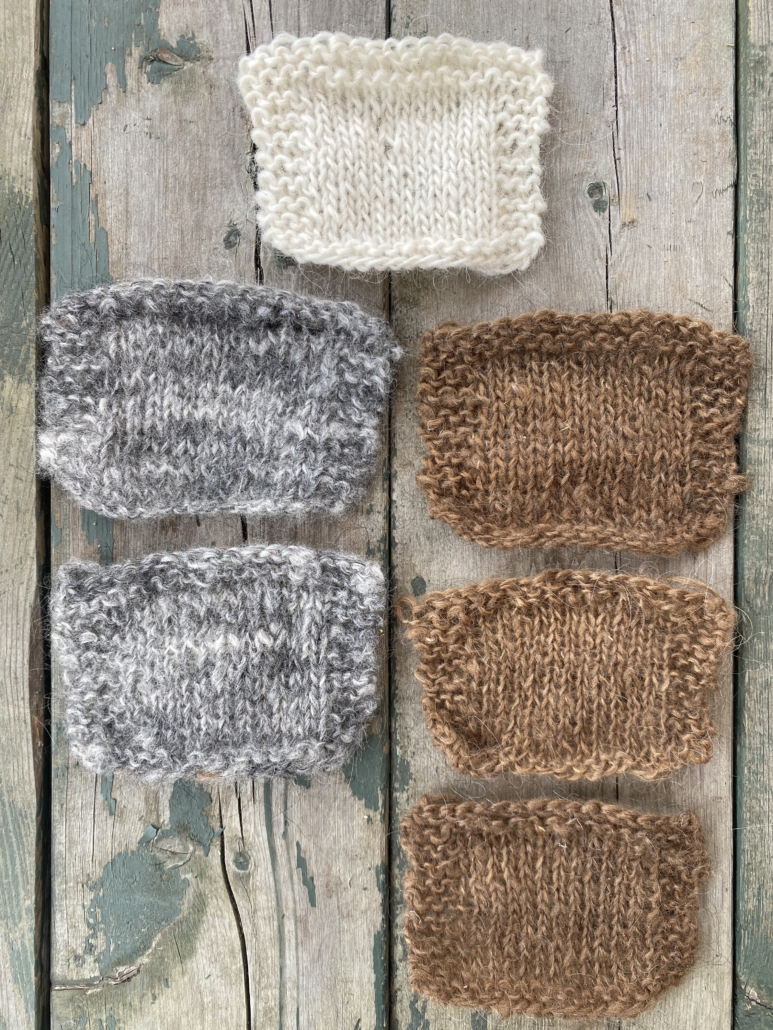
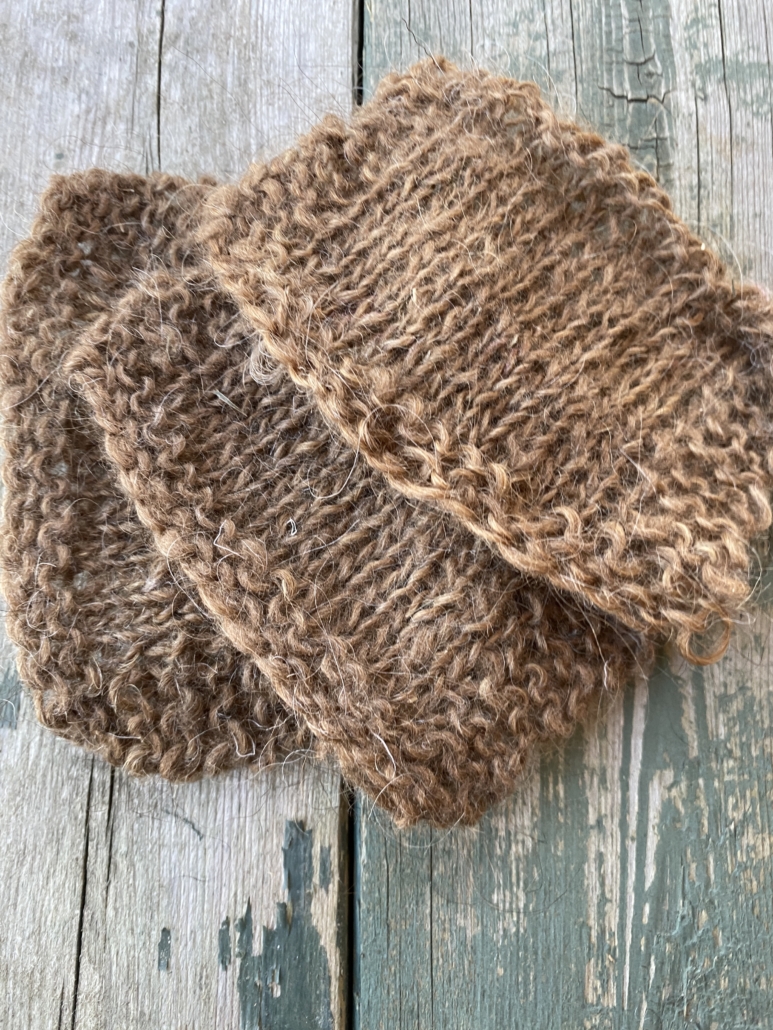
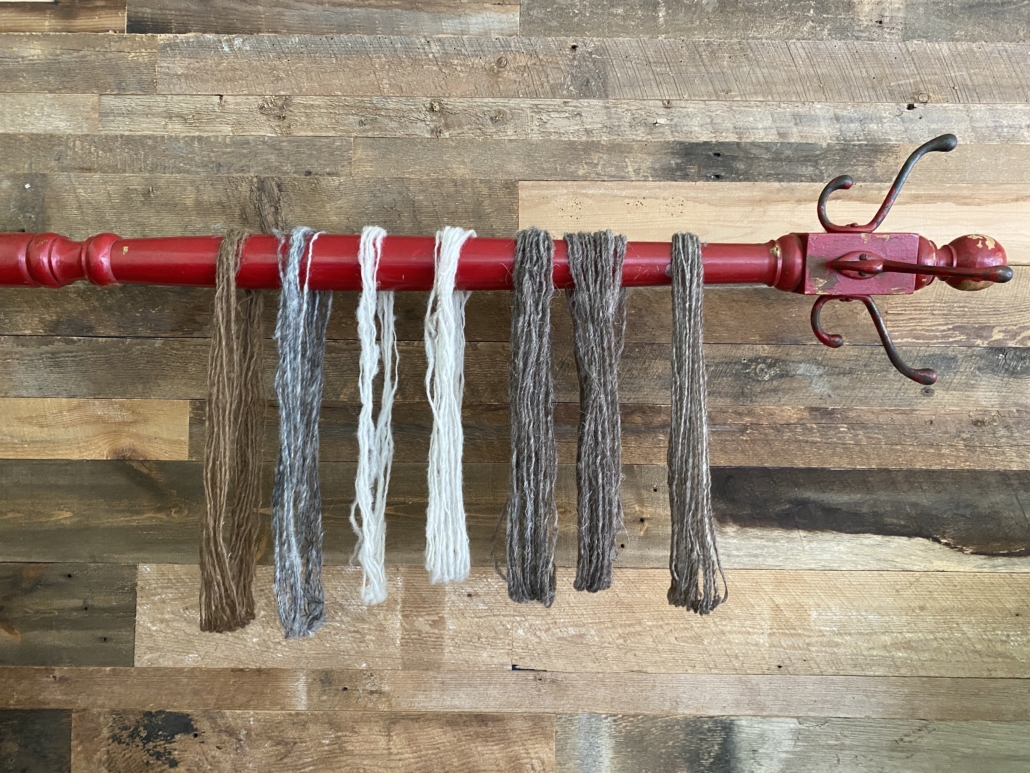
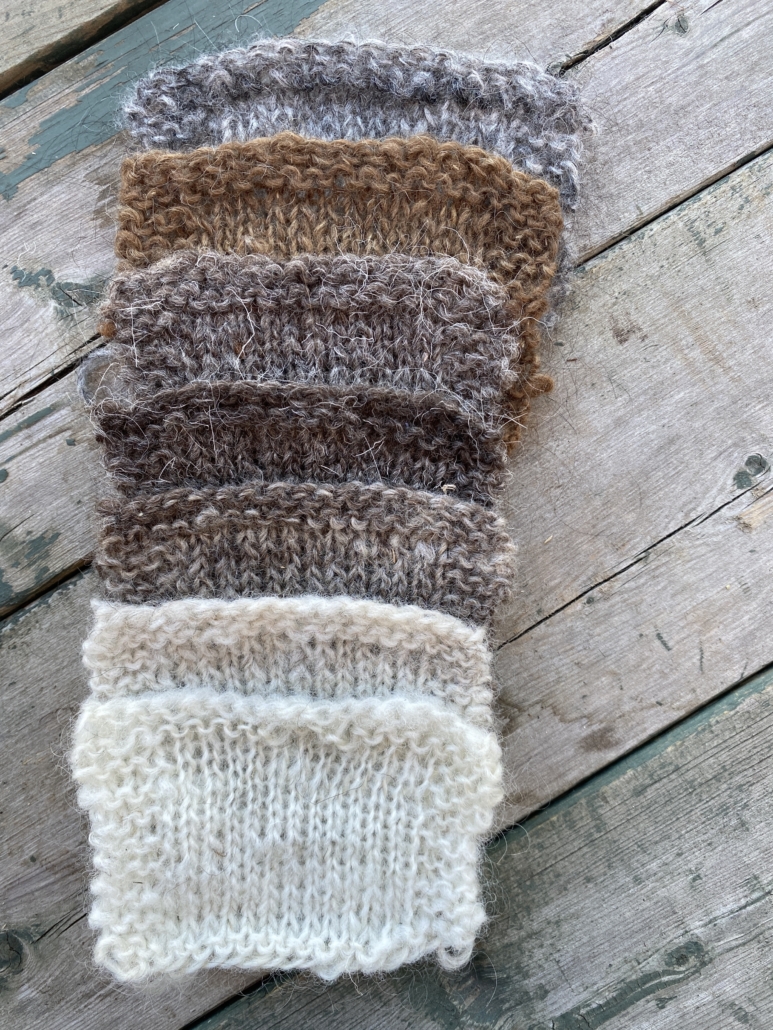


Leave a Reply
Want to join the discussion?Feel free to contribute!